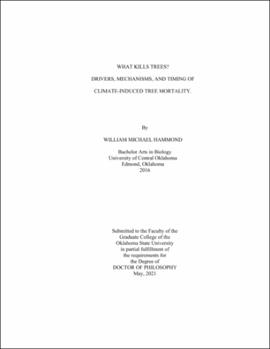| dc.contributor.advisor | Adams, Henry | |
| dc.contributor.author | Hammond, William Michael | |
| dc.date.accessioned | 2022-07-15T21:04:39Z | |
| dc.date.available | 2022-07-15T21:04:39Z | |
| dc.date.issued | 2021-05 | |
| dc.identifier.uri | https://hdl.handle.net/11244/335940 | |
| dc.description.abstract | In recent decades, drought-induced tree mortality has been observed on every forested continent of the planet. This is of great concern, as trees support some of the most biodiverse communities on Earth, are keystones in the planetary carbon and water cycles, and provide both economic and structural support for human civilizations. Determining the drivers, mechanisms, and timing of climate-induced tree mortality is an important step toward understanding the central question of this dissertation: what kills trees? I began searching for an answer locally, in the Cross Timbers of Oklahoma - developing a past-to-present species distribution modeling method to predict present-day range contractions since the 1950s, field-testing these predictions through vegetation surveys and tree-ring studies. While I found higher mortality of juvenile trees in areas predicted unsuitable in the present day, the model overpredicted mature tree mortality. This simple model, and more generally the field of research, lacked critical information: (1) what climate conditions trigger tree mortality during hotter droughts? (2) what is a lethal dose of drought stress for a tree?, and (3) what determines the time-to-mortality under hotter drought stress? The balance of this dissertation seeks to provide initial answers to these pressing questions. Here, I demonstrate that global forests share a common and detectable 'hotter-drought fingerprint', a climate signal for Earth's observed forest mortality sites. This global climate fingerprint reveals that the frequency of potentially lethal climate conditions will accelerate with further warming. Next, I quantify a lethal dose of drought stress for a physiological state (xylem) ubiquitously associated with drought-induced tree mortality. Through drought-rewatering experiments, this work identifies when trees stop living, and start dying. Surprisingly, trees survived much higher levels of xylem dysfunction than expected - revealing that surviving trees retain legacies of dysfunction with long-term consequences. These legacies of dysfunction may reduce resilience and predispose eventual tipping points - initially in community compositions - and eventually in ecosystem states, so their consideration should refine future efforts to model forest mortality. Having bounded environmental drivers and physiological thresholds of tree mortality, I propose a framework of coordinated suites of physiological traits that will improve prediction for time-to-mortality of trees. | |
| dc.format | application/pdf | |
| dc.language | en_US | |
| dc.rights | Copyright is held by the author who has granted the Oklahoma State University Library the non-exclusive right to share this material in its institutional repository. Contact Digital Library Services at lib-dls@okstate.edu or 405-744-9161 for the permission policy on the use, reproduction or distribution of this material. | |
| dc.title | What kills trees? Drivers, mechanisms, and timing of climate-induced tree mortality | |
| dc.contributor.committeeMember | Doust, Andrew | |
| dc.contributor.committeeMember | Johnson, Daniel | |
| dc.contributor.committeeMember | Papes, Monica | |
| dc.contributor.committeeMember | Schonknecht, Gerald | |
| dc.contributor.committeeMember | Will, Rodney | |
| osu.filename | Hammond_okstate_0664D_17063.pdf | |
| osu.accesstype | Open Access | |
| dc.type.genre | Dissertation | |
| dc.type.material | Text | |
| dc.subject.keywords | climate change | |
| dc.subject.keywords | drought | |
| dc.subject.keywords | ecophysiology | |
| dc.subject.keywords | hydraulic failure | |
| dc.subject.keywords | plant hydraulics | |
| dc.subject.keywords | tree mortality | |
| thesis.degree.discipline | Plant Biology | |
| thesis.degree.grantor | Oklahoma State University | |
